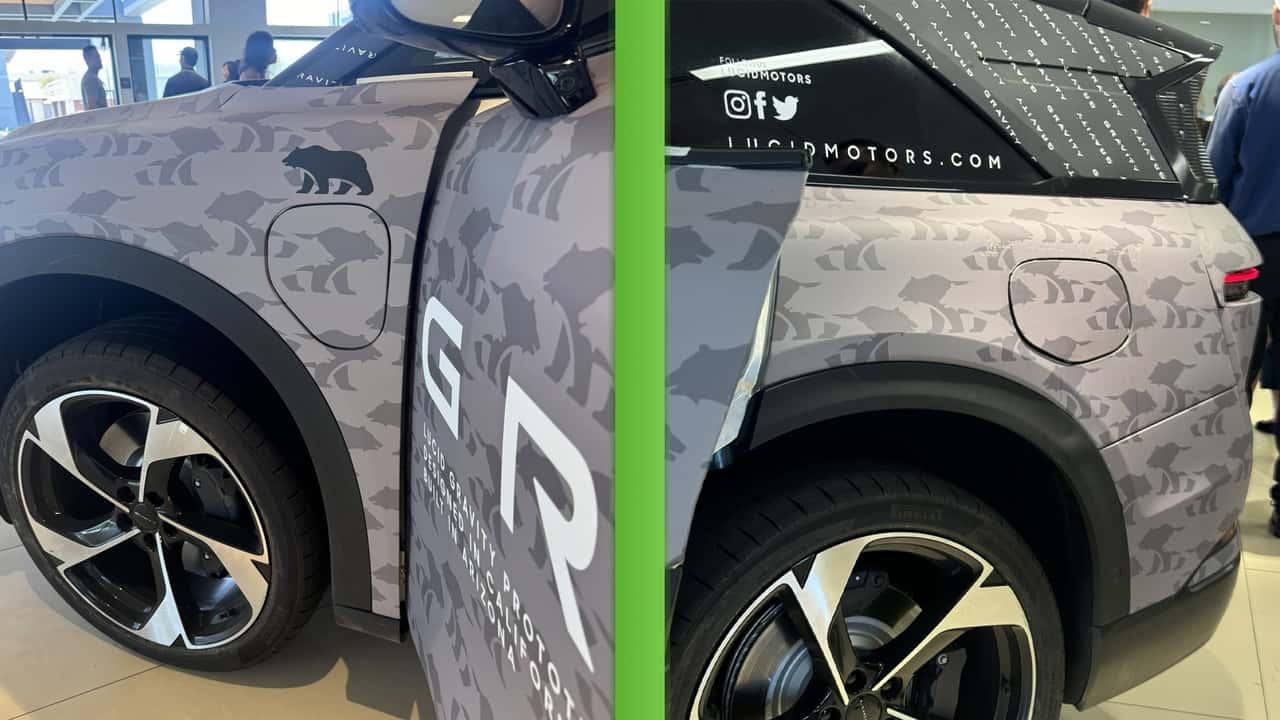- Car companies are migrating from CCS to Tesla’s charging standard, NACs, in order to get Supercharger access.
- Many charging stations still only support CCS, though.
- One report suggests Lucid will offer both ports during the transition period, rather than relying on adapters.
Lucid has figured out a way to fix all of life’s charging problems: just put two charge ports in the car.
Its upcoming three-row Lucid Gravity electric SUV will do exactly that, according to an X user, BLKMDL3, who posted photos from a private event held at the Lucid Studio in Torrance, California. The photos showed Lucid’s camouflaged Gravity EV with what appear to be two charging ports. Lucid’s one-of-a-kind solution, assuming it makes it to production, would allow drivers to charge at just about any charging station, regardless of standard or cable length, and juice up for the drive ahead.
This welcome design isn’t just meant to solve for placement problems. According to the post, the two charge ports won’t just be to accommodate varying cable lengths at different charging networks. The ports will actually be to accommodate different charging standards altogether.
The post claims that Lucid revealed at the event that the Gravity will have one CCS port and one NACS port, making it compatible with virtually every charging network out there—no adapter needed.
Lucid didn’t specify which port would house which charger, however. Though it seems obvious to assume that the driver-side rear port would be the NACS inlet. That location would match Tesla’s existing placement and maximize compatibility with existing V3 dispensers without Gravity owners needing to double park.
InsideEVs reached out to Lucid to confirm if this tech would make it into a production vehicle, but did not receive a response at the time of writing.
This doesn’t solve every charging problem, however, as it’s worth calling out that both ports being in the driver’s side means that curbside charging is a no-go, at least for any country where cars drive on the right side of the road.
Rival automaker Rivian previously announced that it would launch its upcoming R2 SUV with a single charge port on the passenger side, specifically for European customers who would use curbside charging. However, the automaker backpedaled recently and instead moved the charge port to the rear of the R2’s driver side for a reason that it did not specify. We assume it’s for Supercharger compatibility, since it’s a NACS port.
The $80,000 Lucid Gravity is meant to complement the automaker’s sedan, the Lucid Air, which has been around since 2021. According to Lucid, this seven-seat SUV will offer a driving experience that rivals a Lamborghini Urus and be available to buyers later this year. It will also boast a range of more than 440 miles, which means that those charge ports—while extremely convenient—might be used at home more than on the road.
Lucid CEO Peter Rawlinson recently said in an interview that the automaker has “the most advanced technology in the world” at its disposal, enabling it to build some of the most efficient EVs. That being said, this solution adds cost and complexity to its vehicles and Lucid is still losing money with every vehicle it sells, requiring more infusions of cash, the automaker has some serious financial issues to work out in order to stay afloat. Let’s hope the Gravity fixes that.
Lucid Motors, a California-based electric vehicle manufacturer, has announced that their upcoming electric sedan, the Lucid Gravity, will feature both Combined Charging System (CCS) and North American Charging Standard (NACS) charging ports. This decision represents a significant advancement in the electric vehicle charging infrastructure and aims to cater to a wider range of users.
CCS and NACS are two of the most common charging standards used in the electric vehicle industry. CCS is widely adopted in Europe and North America, while NACS is commonly used in North America. By incorporating both standards in the Lucid Gravity, Lucid Motors is ensuring that their customers have access to a comprehensive charging network, regardless of their location.
The inclusion of both CCS and NACS charging ports in the Lucid Gravity is a strategic move by Lucid Motors to eliminate the potential inconvenience faced by electric vehicle owners when charging their vehicles. With a dual-port system, Lucid Gravity users will have the flexibility to choose from a wider range of charging stations, reducing the likelihood of encountering compatibility issues.
Furthermore, the decision to feature both CCS and NACS charging ports in the Lucid Gravity demonstrates Lucid Motors’ commitment to providing a seamless and convenient charging experience for their customers. As the demand for electric vehicles continues to grow, having a versatile charging infrastructure will be crucial in ensuring the widespread adoption of electric vehicles.
In conclusion, the inclusion of both CCS and NACS charging ports in the Lucid Gravity marks a significant milestone in the electric vehicle industry. By offering a dual-port system, Lucid Motors is setting a new standard for convenience and accessibility in electric vehicle charging. The Lucid Gravity is poised to revolutionize the electric vehicle market and contribute to the acceleration of the global transition to sustainable transportation.

